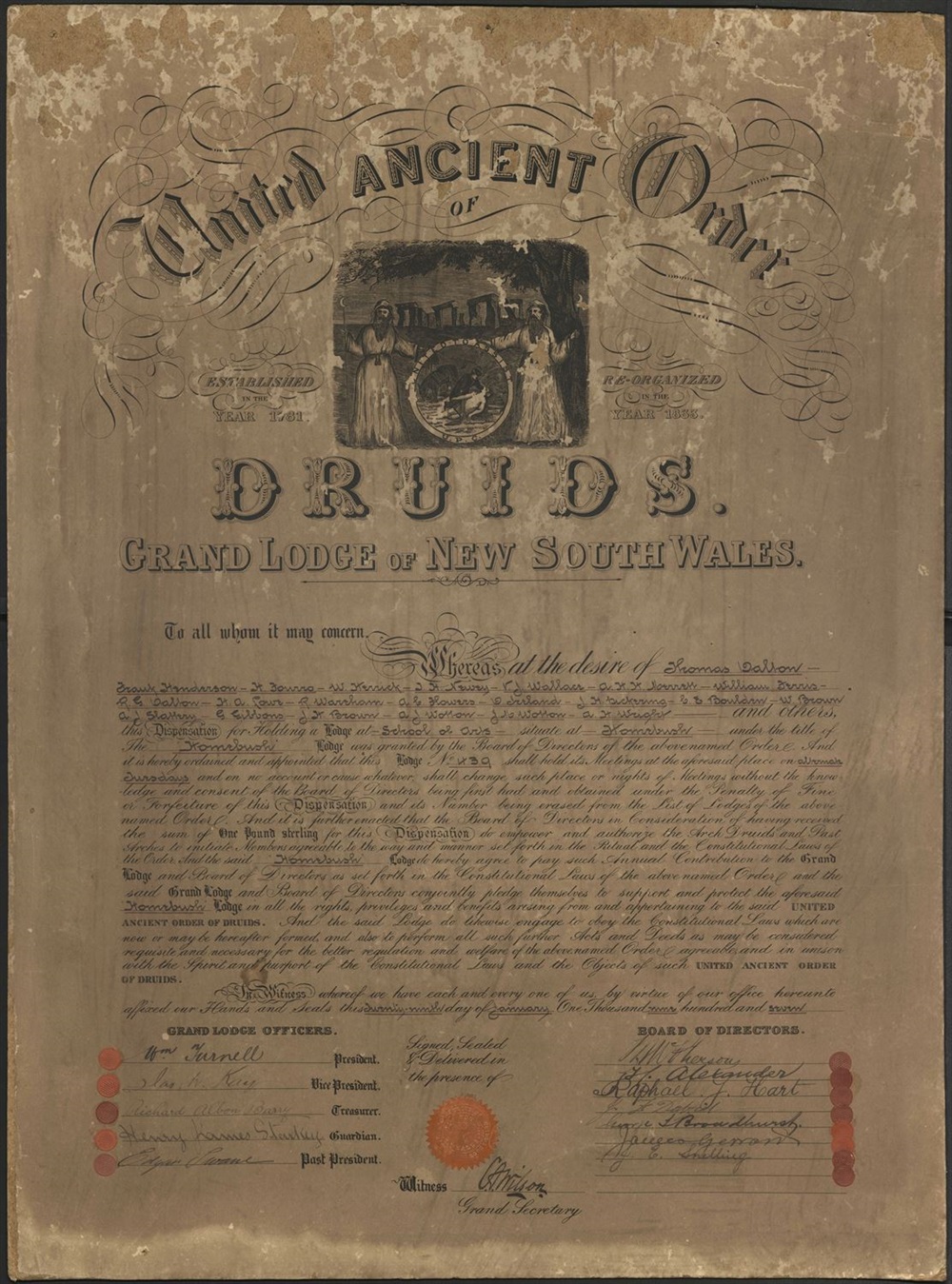Image right: Brother William Herrick of Homebush Lodge, United Ancient Order of Druids. Strathfield Local Studies
Brother William Herrick, a founding member of the Homebush Lodge of the United Ancient Order of Druids, was also an alderman of Homebush Council from 1917 until his sudden death in May 1924, aged 56. Tragically it appeared that he fell over a culvert, landing face down in the creek under Parramatta Road, Flemington, drowning in the mud. The Homebush UAOD Lodge, formed on 29 January 1907, met at the Homebush School of Arts, providing social and financial support for members and their families facing sickness or death.

Charter for the establishment of Lodge 439 Homebush, United Ancient Order of Druids, 29 January 1907. Courtesy Strathfield Local Studies
Druids lived during ancient Celtic days in Britain, Ireland and even France. It is believed that ‘Druid’ can be traced to ‘duir’, the Celtic word for the oak.[1] Hence the inclusion of the oak in more modern times. Britain’s ancient Druids were thought to be enlightened and literate as well as being musical. They sought to keep peace and order and believed strongly in benevolence. The ideal was revived in London in 1781 when the Ancient Order of Druids was created, becoming a social and benevolent society. Following a split, The United Ancient Order of Druids (UAOD) Friendly Society of NSW was established in 1877 with the motto ‘United to Assist.’ Lodge 439 Homebush was formed 40 years later. Members contributed financially, knowing that their families would receive monetary and social support during times of hardship.
William Herrick was born in Nottingham, England c.1868. He married Phoebe Freeman in Granville in 1892 and the couple had six children. The family had settled in Homebush by 1914 when William first stood, unsuccessfully, for election to Homebush Council as an alderman. William Herrick was employed by Arnott’s, conveniently located close to his home Eastfield on Parramatta Road. His son, William Freeman Herrick went on to serve as an alderman on Homebush Council from 1934 to 1937.
According to its charter, Lodge 439 Homebush UAOD was to meet on alternate Thursdays in the School of Arts, Homebush. Other founding members included Alderman Thomas Dalton of Homebush Council, which was incorporated just six months earlier on 6 June 1906. In April 1907, NSW male membership of the UAOD stood at 8277 with another 565 members of the 14 female branches.[2] The July 1909 half-yearly report of Lodge Homebush ‘showed that 18 new members had been initiated and much enthusiasm was being evinced in the progress of the lodge, which was also financially strong. During the evening Bros. Henrick [sic] and Newey were presented with medallions for their services in connection with advancing the interests of the lodge in the Flemington-Homebush district.’ [3]

Sydney Morning Herald 27 May 1924 p.7 https://trove.nla.gov.au/newspaper/article/16154736
Following Herrick’s death on 24 May 1924, the Homebush Lodge invited members to attend his funeral at Rookwood Cemetery. No doubt Phoebe Herrick was grateful for the financial and personal support provided by members after her husband’s sudden death. She remained in her cottage on Parramatta Road for another 30 years and outlived her husband by almost exactly 40 years, dying in May 1964, aged 94. Members of the Herrick family remained in the area for some years, working for local employers. William and Phoebe Herrick’s son, Jack Stanley became a drover and probably worked at the Homebush Saleyards.[4] In 1952 he won £6000 in the lottery.[5] Another son (and later alderman), William Freeman Herrick served with the 12th Light Horse Regiment during World War I. Interestingly he first tried to enlist in 1916 when he gave his occupation as a biscuit maker. His application was refused due to defective eyesight. However when he successfully enlisted the following year he listed his occupation as a horse driver.
With the introduction of government social welfare programs, friendly societies gradually disbanded, although some evolved into financial service providers. Records held by Museums of History NSW suggest that Lodge 439 Homebush continued into the 1970s. The UAOD Friendly Society of NSW was demutualized in 2011 becoming NobleOak Life Limited.[6]
By J.J. MacRitchie
Local Studies Advisor
References
[1] The History of NobleOak, May 2020. https://nobleoak.com.au
[2] The Daily Telegraph 16 April 1907 p.10 https://trove.nla.gov.au/newspaper/article/238050249
[3] The Star 29 July 1909 p.8 https://trove.nla.gov.au/newspaper/article/230482204
[4] 1933 electoral rolls
[5] The Sun 11 December 1952 p.1 https://trove.nla.gov.au/newspaper/article/229639525
[6] The History of NobleOak, May 2020. https://assets.nobleoak.com.au/wp-content/uploads/2020/11/06135100/Druids_Update.pdf